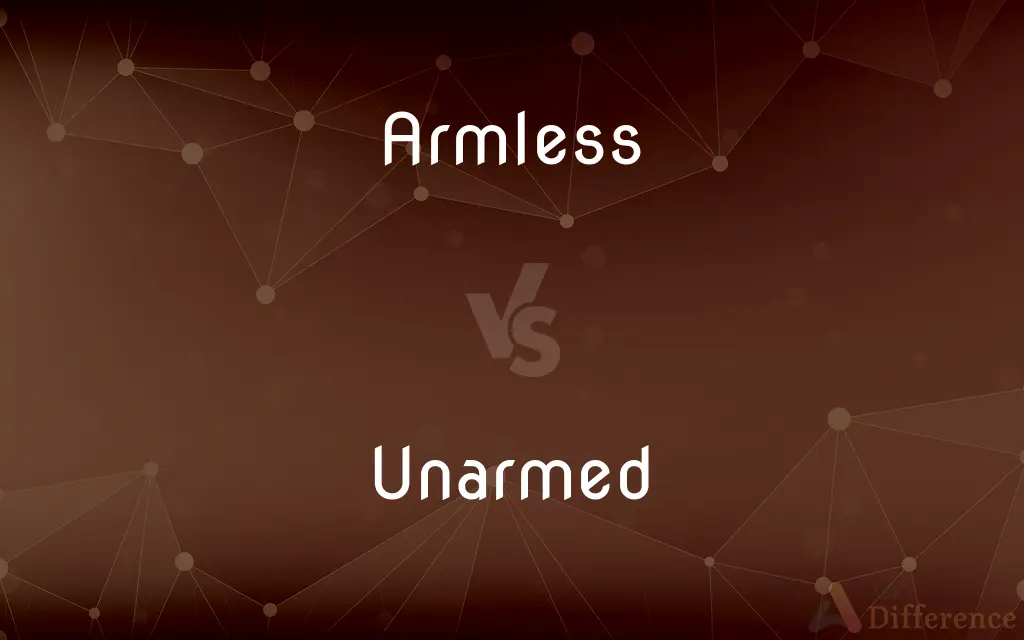Armless vs. Unarmed — What's the Difference?
By Maham Liaqat & Urooj Arif — Updated on April 15, 2024
"Armless" refers to the physical absence of arms, typically used to describe people or statues, while "unarmed" denotes someone not carrying weapons.

Difference Between Armless and Unarmed
Table of Contents
ADVERTISEMENT
Key Differences
"Armless" is primarily used to describe an individual or an object that literally lacks arms or limbs. This term is often applicable in contexts such as medical conditions or descriptions of certain artistic representations. On the other hand, "unarmed" refers to a person who is not equipped with weapons, especially in situations involving potential conflict or law enforcement scenarios.
"Armless" can denote a permanent physical condition or a deliberate design feature, as in the case of armless sculptures or furniture. Whereas "unarmed" suggests a temporary state, indicating that the person could potentially arm themselves under different circumstances.
In discussing legal or security contexts, "unarmed" is a critical descriptor indicating that an individual does not pose a threat through weapons, which can affect law enforcement's response or public perception. Meanwhile, "armless" may be used metaphorically to describe helplessness or inability to perform tasks that require arms.
The implications of being "armless" can affect an individual's daily life and accessibility needs, emphasizing physical limitations and adaptations. Conversely, being "unarmed" might be more relevant to discussions about safety, rights, and personal security.
In literature and art, "armless" can symbolize vulnerability or incompleteness, contributing to a character's development or the thematic depth of a work. On the other hand, "unarmed" often plays a role in narratives about peace, vulnerability, or moral choices in conflict situations.
ADVERTISEMENT
Comparison Chart
Definition
Lacking arms physically
Not carrying weapons
Context
Medical, artistic
Legal, security, conflict
Temporality
Permanent condition or design feature
Temporarily without weapons
Symbolic Meaning
Helplessness, incompleteness
Peace, vulnerability, moral choice
Impact on Persona
Affects accessibility and daily tasks
Affects security and rights
Compare with Definitions
Armless
Designed without arms (furniture).
The modern chair is armless, providing a sleek look.
Unarmed
Not equipped with weapons.
The guards were unarmed during the peaceful protest.
Armless
Incomplete or missing a part.
The puzzle was armless; it lacked several pieces.
Unarmed
Without any tools or equipment.
He entered the survival challenge unarmed.
Armless
Lacking both arms.
The statue was armless, missing both arms from ancient damage.
Unarmed
Not using weapons in a conflict.
They agreed to settle the argument unarmed.
Armless
Unable to use one's arms.
After the accident, he was effectively armless.
Unarmed
Lacking defenses.
The system was unarmed against the new virus.
Armless
Figuratively helpless or powerless.
In the corporate decision-making, he felt armless.
Unarmed
Exposed or vulnerable.
The whistleblower felt unarmed against corporate retaliation.
Armless
Armless is a 2010 comedy film directed by Habib Azar and starring Daniel London, Janel Moloney, Matt Walton, Zoe Lister-Jones and Laurie Kennedy. It was written by Kyle Jarrow.
Unarmed
Lacking weapons or armor; defenseless.
Armless
Having no arms.
Unarmed
Not carrying, using, or displaying arms
An unarmed spotter plane.
Unarmed robbery.
Armless
Without any arm or branch.
Unarmed
(Biology) Having no thorns, spines, teeth, claws, or other protective parts.
Armless
Destitute of arms or weapons.
Unarmed
Defenceless and lacking weapons or armour.
Armless
Having no arms;
The armless Venus de Milo
Unarmed
Not carrying arms.
Unarmed
(biology) Not having thorns or claws etc.
Unarmed
(obsolete) Unaided, as of the vision without a glass.
Unarmed
Not armed or armored; having no arms or weapons.
Unarmed
Having no hard and sharp projections, as spines, prickles, spurs, claws, etc.
Unarmed
Not in a state in which it may be detonated; unable to be detonated; - used of nuclear and certain other explosive devices, which, as a safety precaution, are stored and transported in a state in which normal triggering mechanisms will not function to cause the device to detonate. The weapon must first be armed by a separate action, and only subsequent to such arming will the weapon be able to detonate.
Unarmed
(used of persons or the military) not having or using arms;
Went alone and unarmed
Unarmed peasants were shot down
Unarmed vehicles
Unarmed
Used of plants or animals; without barbs or stings
Common Curiosities
Is "armless" used in medical terminology?
Yes, it can describe a congenital absence of arms or the result of an amputation.
Can "armless" apply to objects other than people?
Yes, it can describe objects like statues or furniture that are designed without arms.
Can "armless" have figurative meanings?
Yes, it can also describe a situation where someone is powerless or lacking influence.
How does "unarmed" relate to legal contexts?
"Unarmed" can influence legal outcomes, particularly in cases involving self-defense or police actions.
What does "armless" mean?
It refers to the absence of arms, either as a physical condition or a design feature.
What are the implications of being unarmed?
Being unarmed can affect one's personal security and the perception of threat in conflict situations.
How is "unarmed" commonly used?
It is used to describe a person who is not carrying weapons, especially in a context of conflict or law enforcement.
What is the importance of being unarmed in peace negotiations?
Being unarmed can symbolize a commitment to peaceful resolution and trust.
How do artists use the concept of armlessness?
Artists might use armlessness to evoke themes of vulnerability or tragedy.
Is there a cultural significance to being unarmed?
In many cultures, being unarmed is associated with peace and non-aggression.
Share Your Discovery

Previous Comparison
Kinesics vs. Proxemics
Next Comparison
Library vs. BibliothecaAuthor Spotlight
Written by
Maham LiaqatCo-written by
Urooj ArifUrooj is a skilled content writer at Ask Difference, known for her exceptional ability to simplify complex topics into engaging and informative content. With a passion for research and a flair for clear, concise writing, she consistently delivers articles that resonate with our diverse audience.
















































